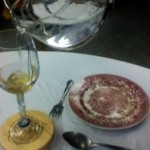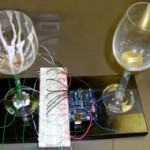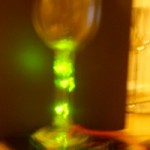Attuned Glasses was my first physical computing project: musical wineglasses for novel social interactions at the dinner table.
The concept behind the musical glasses was to expand upon the resonance phenomenon in crystal glasses (the clear sound produced by running a dampened finger around the rim). We initially thought the glass could be made to similarly resonate different sounds produced by a piezo speaker. However, we found that the particular note each glass played was specific to its unique resonance frequency. We found that the glass did work well in amplifying the sound produced by the piezo, and that the glass interface held potential. At one point in the process of this project, I had a set of different sized glasses filled with water on my counter at home. Naturally, people were intrigued, so I simply showed them the resonance effect. Once they caught on, every person who tried it shifted into “play mode.” One person discovered that by if he pressed harder, the glass would vibrate against the surface it was on and produce what we described as “didgeridoo-like” sounds. Another adjusted the water levels in the glasses and played a simple song. For some reason (perhaps the simplicity and aesthetic appeal of it?) the object invites interaction. We decided to see if we could add more musical possibilities to that while preserving the appeal and the natural modes of interaction.
The current prototype consists of two glasses on a stand wired to the controller board. The first glass has seven locations around its rim that are each associated to a distinct musical note. The glass can be played; by running a finger dipped in water or covered with a conductive material around the edge of the glass, either continuously to play a scale or by activating specific notes. The glass reacts immediately by playing the note for as long as the user continues to activate it. If the user stops playing for a certain time, the entire melody they played will then be played back from the other glass, accompanied by lights embedded in the hollow stem.
How it works
Hardware: Both glasses contain a small piezo speaker at the bottom of the “bowl” which is attached to the programmed unit (an Arduino board). The “playable” glass also has a series of open switches around its rim, each of which are connected to a circuit from ground through one side of the switch and from the other end of the switch to a resistor attached to the digital “high” Arduino pin. The output of these is sent to a pin, which reads whether it is low (switch closed and because of the resistor sent to ground) or high (switch open), and accordingly either plays a note or does not. We made the switches by running parallel conductive traces up the side of the glass, and then soldering those to the wires going to the breadboard. This was in response to one of the project challenges of keeping the aesthetics simple and appealing without compromising the functionality. At first I had the traces taped to the wires at the bottom of the glass, but there was not enough room on the stem to add as many as I wanted and the contacts weren’t very good because of the tape. I solved the first problem by using fine wires running down the stem, and the second with the discovery that while solder wouldn’t take to the glass, it did attach very well to the traces. The second glass contains both the aforementioned speaker and a series of LEDs. These lights and the speaker are activated by another pin on the Arduino board in response to what was played on the other glass.
Software: The Arduino program that controls the glasses runs in a loop, reading the input of each pin in turn. If a pin is low (that switch is closed), it sends a signal to the speaker to play that note (each note is associated with a specific pulse width length). Every time a note is played, the note and duration is recorded. If the time since the last signal was sent passes a certain length (ie. the user stops playing), those values are sent to the second glass, which then plays back the recorded sequence.
Explorations
Some ideas for future directions: The glasses could not only hear every sequence of notes played back, but have “record” and “play”; functionality: he or she would activate a switch or press a button at the beginning and end of a sequence of notes to save a specific melody. The idea is to encourage interactive musical composition. At the moment, chords aren’t possible, because each note comes from a distinct signal sent to the same piezo speaker. I would like to add that possibility, perhaps by using additional glasses to play concurrent notes. One of the things I liked best about the glass alone was being able to play with water and sound. We’re hoping to find a way to isolate the piezo speaker in the bottom of the glass without muffling it so that the user can also modify the sound by adding or removing water (this could possibly be measured by traces on the inside of the glass). So far, we tested protecting the piezo and wires underneath with a layer of hot glue around the edge and found that the sound does not change significantly. Another possibility is to create associated sounds instead of notes: for example, the chime of the glass, water running, or a finger tapping against the edge. Something like this. We could create a game or teaching tool by playing a sequence of notes that the learner has to repeat, with visual (lights!) and audio feedback. I’d like to make the glasses a little more visually appealing. I’d like to try masking the traces on the next prototype and make them look like decoration rather than circuitry. I’d also like to find a way to either embed the wires down the stem into the glass so I don’t have to run the speaker wires up and over the edge, could use the outside of the stem as another interface rather than have it be covered in wires, and also make it less likely to fall apart if mishandled. A Bluetooth or other wireless connection to the other glass(es) would also help with this. I’d like to add additional musical possibilities. Other things we could measure, in addition to chords or water level: taps on the table or edge of the glass, pressure on the stem (based on speed we could increase the volume? Increase or decrease all the notes by an octave?), location relative to other glasses, or orientation of the glass.


